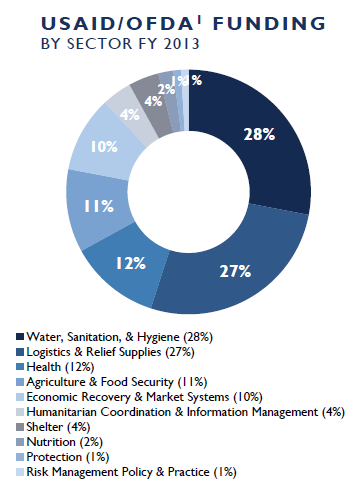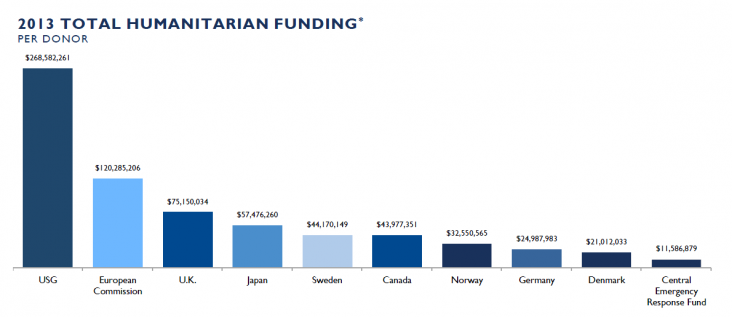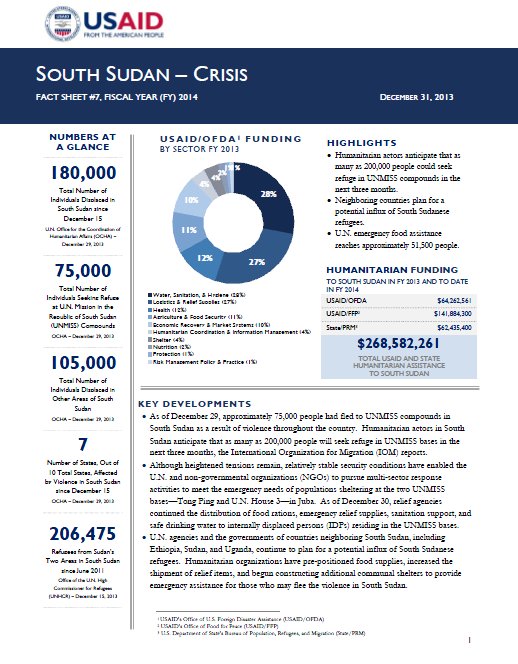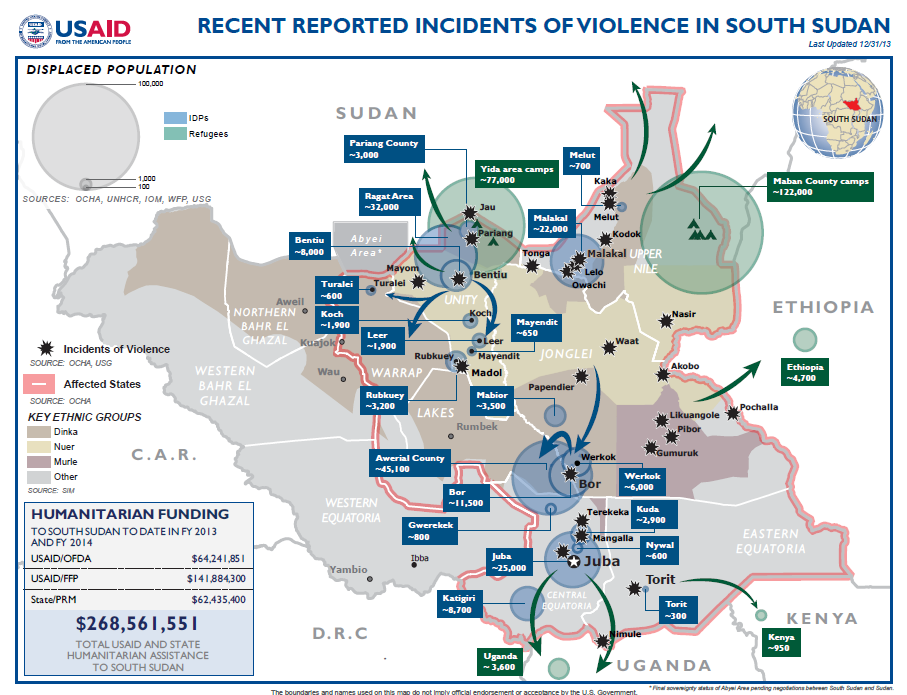- What We Do
- Agriculture and Food Security
- Democracy, Human Rights and Governance
- Economic Growth and Trade
- Education
- Environment and Global Climate Change
- Gender Equality and Women's Empowerment
- Global Health
- Humanitarian Assistance
- Transformation at USAID
- Water and Sanitation
- Working in Crises and Conflict
- U.S. Global Development Lab
Speeches Shim
December 31, 2013
Numbers At A Glance
180,000
75,000
105,000
7
206,475
Humanitarian Funding:
To South Sudan To Date In FY2013 and FY2014:

| USAID/OFDA | $64,262,561 |
| USAID/FFP | $141,884,300 |
| State/PRMDoD | $62,435,400 |
| TOTAL | $268,582,261 |
Highlights
Humanitarian actors anticipate that as many as 200,000 people could seek refuge in UNMISS compounds in the next three months.
Neighboring countries plan for a potential influx of South Sudanese refugees.
U.N. emergency food assistance reaches approximately 51,500 people.
KEY DEVELOPMENTS
As of December 29, approximately 75,000 people had fled to UNMISS compounds in South Sudan as a result of violence throughout the country. Humanitarian actors in South Sudan anticipate that as many as 200,000 people will seek refuge in UNMISS bases in the next three months, the International Organization for Migration (IOM) reports.
Although heightened tensions remain, relatively stable security conditions have enabled the U.N. and non-governmental organizations (NGOs) to pursue multi-sector response activities to meet the emergency needs of populations sheltering at the two UNMISS bases—Tong Ping and U.N. House 3—in Juba. As of December 30, relief agencies continued the distribution of food rations, emergency relief supplies, sanitation support, and safe drinking water to internally displaced persons (IDPs) residing in the UNMISS bases.
U.N. agencies and the governments of countries neighboring South Sudan, including Ethiopia, Sudan, and Uganda, continue to plan for a potential influx of South Sudanese refugees. Humanitarian organizations have pre-positioned food supplies, increased the shipment of relief items, and begun constructing additional communal shelters to provide emergency assistance for those who may flee the violence in South Sudan.
SITUATION AND DISPLACEMENT UPDATE
The security situation across conflict-affected areas in South Sudan remains fluid. The situation in Juba remains calm but tense and has allowed increased delivery of humanitarian assistance to affected populations, despite continuing tensions. According to the U.N., as many as 29,000 people are residing in UNMISS compounds in Juba as of December 29.
An estimated 6,000 people are displaced in Werkok, Jonglei State, according to the U.N. Approximately 11,000 people are sheltering in UNMISS bases in Bentiu and Pariang, Unity State, in addition to 7,000 individuals seeking refuge outside of UNMISS compounds. In Upper Nile State, where conflict is reported in Malakal, Nassir, and Ulang counties, as many as 22,000 people are residing in the UNMISS compound in Malakal as of December 29.
As clashes continued in Upper Nile and Jonglei states between December 27 and 29, humanitarian actors in Sudan continued to prepare emergency response plans to assist individuals who may flee from South Sudan to neighboring Sudan. The U.N. reports that relief agencies have begun planning activities for an estimated 350,000 refugees and identified three potential corridors that people may use to cross between the countries.
Approximately 32,000 people attempting to seek refuge in Sudan remain stranded at the Sudan–South Sudan border, just south of Heglig town, Southern Kordofan, according to OCHA. Humanitarian organizations are attempting to negotiate with armed actors to gain access to the area in order to provide assistance to displaced populations.
U.N. agencies and the Governments of Ethiopia and Uganda are also preparing for a potential influx of South Sudanese refugees. To date, nearly 3,600 refugees have crossed into Uganda since December 15, and approximately 950 people have arrived in Kenya, according to UNHCR. UNHCR reports that at least 4,700 refugees have crossed into Ethiopia since December 15, with other humanitarian organizations indicating that the number could be larger.
South Sudan Crisis Fact Sheet #7 December 31, 2013 ![]() (pdf - 340k)
(pdf - 340k)
HUMANITARIAN RESPONSE IN JUBA, CENTRAL EQUATORIA STATE
Relief agencies continue robust efforts to provide humanitarian assistance to populations sheltering at UNMISS bases in Juba. Between December 23 and 29, more than 12,600 people—approximately 4,500 households—registered as IDPs in the UNMISS Tong Ping base and received food rations and emergency relief supplies, such as blankets, sleeping mats, and basic kitchen items, IOM reports. IDP registration is slated to begin on January 1 in the UNMISS U.N. House 3 compound.
As of December 30, relief agencies had erected nearly 20 tents, capable of sheltering up to 850 people, for displaced families in the Tong Ping compound.
The U.N. World Food Program (WFP) had provided emergency food assistance to approximately 51,500 people displaced by recent violence in South Sudan as of December 30. Of the total, WFP had distributed one-week food rations to approximately 27,000 people in the Juba UNMISS bases since December 22, as well as 8,200 IDPs in Bentiu, Unity State, and 7,500 in Mingkamam, Lakes State.
On December 30, WFP-managed U.N. Humanitarian Air Service (UNHAS) began operating a two-week temporary flight service between Juba and Nairobi, Kenya, to help relief workers better access affected areas.
South Sudan Crisis Map December 31, 2013 ![]() (pdf - 413k)
(pdf - 413k)
HUMANITARIAN NEEDS AND RESPONSE IN OTHER AREAS OF SOUTH SUDAN
Humanitarian agencies continue efforts to provide critical humanitarian assistance to areas outside of Juba, as security, staffing, and access permit, and are scaling up assessment activities to identify priority needs among affected communities.
Following an interagency assessment, the U.N. reports that an estimated 15,000 people have sought shelter in the UNMISS compound in Bor, Jonglei State, as of December 26. Insecurity has prevented the distribution of food assistance, but relief agencies are working to improve security and sanitation services. IOM reports that IDP registration and distributions will likely begin in early January.
As security allows, relief organizations are planning an assessment mission to Awerial County in Lakes State on December 31, after receiving reports of as many as 60,000 people displaced in the area. The U.N. previously reported that local authorities and relief organizations have provided food commodities and other relief items—including medical supplies—to IDPs in Awerial. WFP is making arrangements to transport food items to assist 30,000 people in the area.
Camp management staff recently identified health, food assistance, emergency relief supplies, and water, sanitation, and hygiene (WASH) support as priority needs in the UNMISS base in Malakal, Upper Nile State, where an estimated 22,000 IDPs reside after nearby violence forced many to flee their homes. In response, U.N. and NGOs continue to increase support for IDPs.
By request of the WASH Cluster—the coordinating body for WASH activities, comprising U.N. agencies, NGOs, and other stakeholders—IOM has begun conducting WASH assessments at the Malakal base and has deployed support staff to assist in the implementation of activities as of December 30.
WFP, in cooperation with UNMISS in Malakal, is coordinating food distributions, reaching nearly 5,300 IDPs with seven-day food rations as of December 30.
IOM plans to facilitate IDP registration and provide camp management support in Lakes, Unity, and Upper Nile states in the coming weeks.
The Government of Ethiopia continues to plan for a total of 30,000 new arrivals—15,000 for Akobo, Gambella Region, and 15,000 for Asosa, Beneshangul-Gumuz Region. WFP has prepositioned high-energy biscuits, sufficient to feed up to 7,400 people for three days, in Gambella. Meanwhile, UNHCR is building additional communal shelters and WASH facilities at Ocea and Dzaipi reception centers and is ramping up shipments of food commodities and other relief items, including medical supplies, to northern Uganda.
OTHER HUMANITARIAN ASSISTANCE
The U.N. released its South Sudan Crisis Response Plan for January–March 2014 on December 31. The Response Plan—prepared by the Humanitarian Country Team—details the humanitarian community’s funding requirements to address the humanitarian needs of an estimated 400,000 IDPs and 228,000 refugees. Priority needs are camp management, food and livelihoods, health, protection, shelter, and WASH, in addition to the ongoing response to refugees already living in South Sudan. The Response Plan calls for $209 million; however, the South Sudan Common Humanitarian Fund—a pooled, multi-donor fund used to support timely allocation and disbursement of donor resources to meet urgent needs and critical gaps—has already mobilized $43 million of the total, leaving a shortfall of $166 million. The U.N. notes that the Crisis Response is taking place in an already complex humanitarian emergency marked by large-scale humanitarian needs; the 628,000 people in need as a result of the current crisis are only a portion of the total 4.4 million people in need across South Sudan.
2013 TOTAL HUMANITARIAN FUNDING*

**Funding figures are as of December 31, 2013. All international figures are according to OCHA’s Financial Tracking Service and based on international commitments during the 2013 calendar year, while USG figures are according to the USG and reflect the most recent USG commitments based on the 2013 fiscal year, which began on October 1, 2012, and ended September 30, 2013, as well as the 2014 fiscal year, which began on October 1, 2013.



Comment
Make a general inquiry or suggest an improvement.